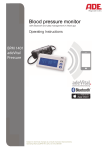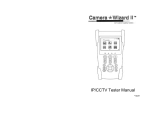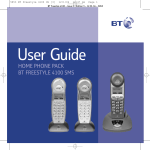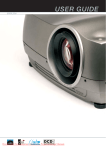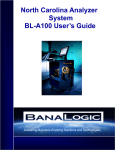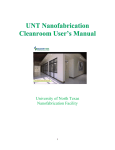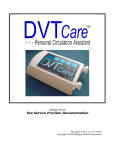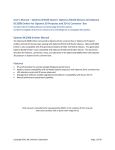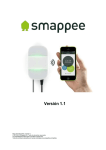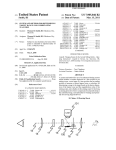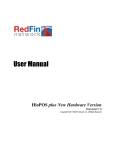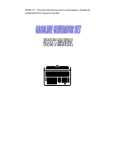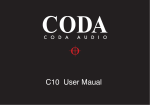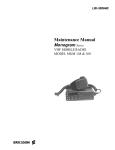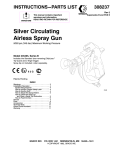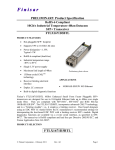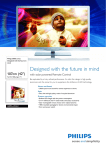Download Drive Medical Design Mobility Aid 2850-18 User's Manual
Transcript
TRID DENT T POW WER WHE W ELCH HAIR R Owneer's Opperatiion Manual M l M MODEL # 2850-188 & 2850-220 #s Read d all precaautions andd instructioons in this manual before using this equiipment. Savee this manuual for futu ure referennce. CONTENTS FORWARD ----------------------------------------------------------------------------------------------------------- 6 PRODUCT DIRECTION ----------------------------------------------------------------------------------------SPECIFICATION ------------------------------------------------------------------------------------------------------- 6 7 CAUTIONS BEFORE USE ------------------------------------------------------------------------------------------------ 8 1. Driving 2. Terrain 3. Slope 4. Attendant 5. Other UNPACKING & ASSEMBLY-------------------------------------------------------------------------------------- 10 ADJUSTMENT---------------------------------------------------------------------------------------------------------------- 14 1. Headrest height adjustment 2. Armrest Height Adjustment 3. Back angle adjustment 4. Retractable Joystick 5. Footplate height adjustment OPERATION ---------------------------------------------------------------------------------------------------------------1. Sit On 2 Get Up 3. Clutch 4. Battery Charger and Battery Charging 5. Controller 6. Take off the battery cases 7. Wiring diagram 17 8. Flash code 9. Operation 10. Security Function: TRANSPORTATION AND STORAGE------------------------------------------------------------------------------1. Transportation 2. Storage MAINTENANCE --------------------------------------------------------------------------------------------------------1. Cleaning and Check-Up 2. Maintenance and Controller self-check WARRANTY --------------------------------------------------------------------------------------------------------------- 2 28 29 31 FO ORWAR RD Eleectromagnettic emissions informatioon The Trident is intended i foor use in thee electromaagnetic enviironment sp pecified bellow. The cuustomer of the Trideent should aassure that itt is used in such s an enviironment. Emisssions test Com mpliance Electromagnetic envirronment - guuidance RF emissions Grouup 1 The Tridennt uses RF energy e only for its internnal CISP PR 11 function. Therefore, T itts RF emissiions are veryy low and arre not likely to t cause anyy interferencce in nearby electronic equipmentt. RF emissions Classs B including domestic d esttablishmentts and those directly CISP PR 11 Harm monic emissions The Tridennt is suitablee for use in all a establishhments, Not applicable a IEC 61000-3-2 6 Voltaage fluctuatiions / Not applicable a flickeer emissionss IEC connected to the publiic low-voltaage power suupply netwoork that suppliies buildingss used for doomestic purpposes. 6100 00-3-3 3 FORWARD Guidance and manufacturer’s declaration - electromagnetic emissions information The Trident Image Intensifier is intended for use in the electromagnetic environment specified below. The customer or the user of the Trident Image Intensifier should assure that it is used in such an environment. IMMUNITY test IEC 60601 Compliance level Electromagnetic environment - guidance Test level Electrostatic Floors should be wood, concrete or ceramic ± 6 kV contact ± 6 kV contact Discharge (ESD) ± 8 kV air tile. If floors are contain synthetic ± 8 kV air IEC 61000-4-2 material, the relative humidity should be at least 30%. Electrical fast Not applicable Mains power quality should be that of a ± 2kV for power Transient/burst typical commercial or hospital environment. Supply lines ± 1kV for IEC 61000-4-4 input/output lines Surge Not applicable Mains power quality should be that of a ± 1 kV line(s) to IEC 61000-4-5 typical commercial or hospital environment. line(s) ± 2kV line(s) to earth Voltage dips, <5% U T Mains power quality should be that of a short (>95% dip in U T) typical commercial or hospital environment. interruptions and for 0.5 cycle) If the user of the (ME EQUIPMENT or ME voltage variations SYSTEM) requires continued operation during power mains interruptions, it is on power supply 40% U T input lines (60% dip in U T) Not applicable recommended that the (ME EQUIPMENT or for 5 cycles ME SYSTEM) be powered from an IEC 61000-4-11 uninterruptible power supply or a battery. 70% U T (30% dip in U T) for 25 cycles <5% U T (95% dip in U T) for 5 s Power frequency 3 A/m Not applicable Power frequency magnetic fields should be at (50/60 Hz) levels characteristic of a typical location in a magnetic field typical commercial or hospital environment. IEC 61000-4-8 NOTE U T is the a.c. mains voltage prior to application of the test level. 4 FO ORWA ARD G Guidance annd manufactturer’s declaaration - elecctromagneticc emissions informationn u in the electromagn e etic environnment specified below. The custom mer or the user u of The Trident is suitable for use T shouuld assure th hat it is usedd in such an electromagnnetic environment. the Trident IMM MUNITY tesst IEC 606011 Compliaance Elecctromagneticc environmeent - guidancce TEST LE EVEL level Not appliccable Radiated RF 3 V/rms Portable and moobile RF com mmunicationns equipmen nt n closer to and part of the (ME shouuld be used no 6 IEC 61000-4-6 150 kHz to 80 MHz EQU UIPMENT or o ME SYST TEM), incluuding cabless, thann the recomm mended sepaaration distaance calculatted ducted Rf 3 V/m Cond 10 V/m from m the equatioon applicablle to the freqquency of thhe IEC 61000-4-3 6 t 25 MHz 80 kHz to transsmitter. Recommended d separation n distance d = [ 3,5 / V1 ] √P d = [ 3,5 / E1 ] √P 80 MHz M to 800 MHz d = [ 7 / E1 ] √P √ 800 MH Hz to 2.5 GHzz wherre P is the e maximum output o powerr rating of the e transsmitter in wa atts (W) acccording to th he transmitte er manuufacturer and d is the recoommended seeparation distance in metress (m). Fieldd strengths from fr fixed RF R transmitterrs, as deter--mined by an a electroma agnetic site survey, s ª should be lesss than the compliance c e level in ea ach frequency range. B Interrference may occur in n the vicinitty of equipment marrked with the e following symbol: NOT TE 1 At 80 M MHz and 8000 MHz, the higher freqquency rangee applies. NOT TE 2 These guidelines may not appply in all situations. s E Electromagn netic propag gation is afffected by absorrption and reeflection froom structurees, objects annd people. a Fiield strengthhs from fixeed transmitteers, such as base stationns for radio (cellular / cordless) c tellephones annd land mobile radiios, amateurr radio, AM and FM raddio broadcasst and TV broadcast b can nnot be preddicted t electrom magnetic envvironment du ue to fixed RF R transmittters, an theorretically witth accuracy. To assess the electrromagnetic site survey should be considered. c I the measuured field strrength in thhe location inn which the If (ME EQUIPME ENT or ME SYSTEM) is i used exceeeds the appplicable RF compliance c level abovee, the (ME UIPMENT oor ME SYST TEM) shoulld be observved to verifyy normal opeeration. If ab bnormal perrformance iss EQU obserrved, additioonal measurres may be necessary, n such s as re-orrienting or relocating r th he (ME EQU UIPMENT or o ME SYSTEM). S b Over O the freqquency rangge 150 kHz to t 80 MHz, field strenggths should be lsee than n [V1] V/m. 5 FORWARD FORWARD: Thank you for choosing the Trident power wheelchair. For safety and others, please read this user's manual carefully before operation. (1) Please read every detail in the manual before operation and maintenance. (2) Please carry the user's manual with you for reference and familiarity on how to operate/drive this power wheelchair. (3) This user's manual is a part of the power wheelchair, please keep it with the chair at all times. PRODUCT DIRECTION: The maximum load capacity is (300 pounds) with damper and pneumatic tires to support user weight against vibration from all terrains while driving. Be sure to read all instructions carefully before attempting to use. Being familiar with the product operation and functionality will ensure the safety of operation for users and others. Since the Trident power wheelchair consists of delicate electronic devices such as a joystick and controller, be careful during transportation and storage. Be sure to keep it away from violent collision or high humidity. Use a dry fabric to wipe up any moisture. 6 SPECIFICATIONS SPECIFICATIONS Trident Seat width 49cm / 19" Seat depth 49cm / 19" Back height 48cm / 19" Overall length 110cm / 43" Overall height 116cm / 46" Overall width 64cm / 25" Ground clearance 5cm / 2" Max. Speed 8km/h Caster wheel 8" Drive wheel 14" Max.user weight 135 kgs / 300 lbs Charger 24V/ 5A, off-board Battery 12V 36Ah*2 Motor DC 24V 320W* 32: 1*2 All specifications and designs are subject to change without notice. 7 CAU UTION NS BEFO ORE US SE CAU UTIONS BE EFORE USE E: For th he best perfformance annd safe operaation, read the t followinng instructionns: (1) Driving: D 1. Be careful aand understaand the speeed buttons on o the controol panel. Staart from slow west level annd practice in wide open spaaces. 2. Do not stepp directly onnto the footpplates when entering e or exiting from m the powerr wheelchairr. 3. Make sure user's feet are on foottplates while sitting onn the power wheelchairr, and buckle up with arm ms on armreests. 4. Contact youur dealer im mmediately inn case of an ny abnormallity or operaational issuees. 5. Drive safelyy at steady speed. s DO NOT N make sharp s or quiick turns. 6. Be sure to ffollow the loocal traffic ruules while driving d outdooors. 7. Keep user's weight inclluding luggaage under liimit of (300llbs) all the time. t 8. Each powerr wheelchaiir is for onlyy one user at a a time. Ovverloading the t power wheelchair w c could cause dam mage to thee product or battery, andd create an unsafe u operaational conddition. (2) Teerrain: 1. Av void driving in traffic. 2. Drriving on roaad instead off sidewalk/ppavement is not recomm mended. 3. Do o NOT drivee on grass, sand, s mud, gravel, g ice and a other slipppery terrains. 4. DO O NOT drivve outdoors in i fog, rain, snowy or wet w terrain. (3) Slope: S 1. Do o NOT drivee on slope, sliding s or deeclining terrrains. 2. Bee sure to slow w the speedd when comiing down ann incline or hill, h lowest speed is reccommendedd. 3. Do o NOT drivee on slope ovver 6 degreees at any tim me. 4. Bee sure to keeep wheels inn vertical position againnst curbs or stairs s when crossing. 5. Keeep both cluutch levers inn the engageed position, parallel to the t drive whheels, when climbing onn slopes. When W the moto or levers are in the disenngaged posittion (Fig.5-2 2), the vehiccle cannot bee operated by b the controoller. (Fig. 5-1 DRIVE) (Fig. 5-2 PR ROPEL) 8 CAU UTION NS BEFO ORE US SE (4)Atttendant: a. Make sure the t user sits in the poweer wheelchaair, and havee the user's feet f on the footplate. f b. Keep the motor m lever at engaged position (F Fig. 5-1) to ensure brak king when the t power wheelchair w is i powered offf. (5)Otther: a. When W the w wheelchair's power is in the ON possition, DO NOT N use a cell/mobile c p phone or anny wireless device d to avoid possiible interferrence to conntroller by electro e feeddback. Also keep away y from high voltage or radio transmitter. Bee sure to sw witch off thee power whheelchair and ask for help in case of abnormaal movemennt resulting from un nexpected eleectro interfeerence. b. Keep the poower wheelcchair away ffrom dampnness or storaage under hiigh humidityy. Wipe off moisture with w dry y, clean withh soft fabricc as soon as possible. c. Be B sure to ppay attention n to the warrnings, suchh as weight capacity waarning stickker on the reear of frame shown by y the followiing picture; keep them clean c on thee power wheeelchair. 9 UNP PACKIN NG & AS SSEMB BLY PA ARTS: (Stanndard) Contaains 1 of eachh of the follo owing Retractablee joystick X 1 Optional acccessories) PARTS: (O 10 UNP PACKIN NG & AS SSEMB BLY Warning: H W Have two peoople take caare of the seaat disassembbly and trannsportation. Unpack youur pow wer wheelchaair where it will be usedd. Be carefuul not to dam mage anythinng during thhe unpackinng p process. Plaace your pow wer wheelchhair on a lev vel flat surfaace. It is reco ommended that you plaace a protective c covering onn your floor.. 1-1. T Take out the left/ rightt armrests assemblies a f from carton and insert them into the t adapterss oon the back of seat fram me as shown n in the folloowing picturre. Tighten them t by thee knobs. 2-1. IInsert the jo oystick bracce into the armrest a adaaptor and tig ghten up wiith knob. U Use 3 pieces of the cable ties to fixx the joystickk cable to th he armrest tuube. 11 UN NPACKIING & ASSEM A MBLY Warning: Have two o people insstall the seatt assembly. 3-1. Plug inn the joystickk cable withh the controll module whichh is located under u the seaat frame. 4-1. Takee the seat fraame out from m carton. Pu ut the seat frrame onto thhe power baase. (Fig.12--1) 4-2. Pushh the seat bacckward and make sure the t pin locks with the fixing brracket on booth sides. (Fig.12-2) (F Fig.12-2) (Fig.12-1) 12 UNP PACKIN NG & ASSEMB A BLY 2 of 15m mm screws tighten t the seat s frame with w power frame. f Optioonal “quick release” pinns may be 5-1. Use 2pcs used for ffaster assem mbly and disaassembly. 5mm X 2 15 6-1. Inssert the head drest braces into the adaapters on seaat back. 13 ADJU USTME ENT ADJU USTMENT T: 1. Heeadrest heighht adjustmen nt: Depress the buttoon latch; adjjust the headdrest to the proper p posittion. 2. Arrmrest Heighht Adjustment: Heeight : Use Allen Key to release the t armrest screws andd adjust arm mrest height, maximum m up to 1 ¾”, ¾ and then fassten the screews. h Width : Loosen the armrrest knobs annd adjust arm mrest widthh, and then fasten f the knnobs. (Fig.144-1) Flip-U Up : For uuse's conven nience whenn transit, the maximum fflip-up anglle is 90 degrree. (Fig.14--2) (Fig.14-2) (Fig.14-1) 14 ADJU USTME ENT 3. Baack angle adj djustment: Pull up u the lever at left side of seat. Andd adjust the back to prooper position n. (Range: 100°~125°) TIONAL 4. Reetractable Joystick: OPT 1. Pull up the piin from bracket. (Fig.15--1) 2.Sw wing the joyystick to thee bottom andd insert the pin p again intto the brackket. (Fig.15-2) (Fig.15-2) Fig.15-1) (F 15 ADJU USTME ENT 5. Footplate heigght adjustmeent: Loosen the screw w by Allen Keys, K adjustt the footplaate height acccording to user’s comffort. 16 OPE ERATIO ON 1. Sittting: It is im mportant andd necessary to confirm the followinng instructio ons for user''s safety. (1 1) Be surre to keep th he power offf (power ind dicate is off as well) beffore the userr sits down. (2 2) (3 3) (4 4) (5 5) User may m enter fro om the frontt or the sides by lifting the t arms outt of the wayy. Have uuser's feet reest on footpllates. Bucklee up the safeety belt; theen fasten thee belt to propper length upon u the user's comfort. Switchh on the pow wer. Warning: Do NOT T stand on footplates f w when sitting down or gettting up from m the seat, which w will cauuse an unballanced conddition and jeopardize thee user's safeety. Be sure to switch off the power p and make m sure th he motor braake levers are a in the enggaged positiion before sitting s downn or getting up u from the seat. 2. Staanding: It is important and a necessarry to confirm m the follow wing instrucctions for usser's safety: (1)Move thee power whheelchair andd user close to destinatioon. (2)Be sure tto keep the power p off (ppower indiccate is off ass well) beforre the user gets g up. (3)User getss up by arm mrest or otherr supporting g method. 3. Cllutch:Wheen the pow wer is off, tturn the cluutch to diseengaged po osition by hand h to push the pow wer wheeelchair. (1) Motor Driving: D Maake sure the power is off ff, turn the cllutch lever to t the engag ged positionn, make the clutch c levvers headingg toward fronnt and paralllel to drive wheel, the power p wheeelchair can be b driv ven by motoors and electtromagneticc brake workks when eng gaged. (2) Propelliing: Make sure s the pow wer is off, turn t the cluttch lever too disengagedd position and a let the llevers vertical to the drivve wheels. Then T it is reaady to push the t power wheelchair w b hand. by (DRIIVE) (PUSH H) Warnning: Be surre to switch off the pow wer before sw witching thee clutch leveers, and keepp away from m others and a childrenn. For user'ss safety, do not n leave alone in the power p wheellchair when thhe clutch levvers are in th he disengagged position.. 17 OPE ERATIO ON 4. Baattery Charger and Batteery Chargingg Be B sure to hhave the baatteries com mpletely chaarged beforee using the power wheeelchair, esppecially forr long distance d drivving. Check to see if thee power is loow accordinng to the pow wer indicatoor on controlller. Warrning: Do NOT N expose batteries too direct sunshine or closse to thermaal/heat sourcces. Do NO OT remove the batteriees of the pow wer wheelchhair before unplugging. u Do NOT N switch on the pow wer while chharging the batteries. Have the bbattery chargger stoweed after charrging. Follo ow up these instructions to charge thhe battery: (1) Take out the battery charrger; plug inn the round shape conneecter (Fig. 18-1) 1 to the socket on jooystick (F Fig. 18-2), hhave the cabble cord connnected to AC A socket, annd switch onn the battery y charger foor power chharging. Pow wer cord (Fig. 188-2) (Fig. 18-1) The battery b chargging usually y takes 8 to 10 hours in case of usinng original battery b charrger, dependding on the batterry age and ppower volum me left in baatteries befoore charging. For best poower outputt, new batterries are recom mmended too be chargedd 24 hours att initial usagge. (2) Sw witch off thhe battery ch harger; discoonnect plugss/connectorss from sockkets. (3) To T keep the batteries' working w life as long as possible, reegular batterry chargingg everyday is i recommeended. Week kly battery ccharging is recommend r ded for long term periodds between use u or storagge. (4) Battery B damaage could bee dangerous. Contact your y dealer to t change baatteries. Botth batteries are a designed d to be chhanged sim multaneously y. Changing only one baattery will cause c a pow wer imbalancce and conseequently jeoopardize thhe new one. w use hermettically sealedd airtight leaad-acid batttery. For useer's Warning: Power wheelchairs conveniience, there is no need to t add waterr or any liqu uid; thereforre, DO NOT oppen batteriess under any circumstannces, otherw wise batteriess will absoluutely be out of warranty w andd unable to use. u Makee sure of thhe battery charger c is thhe original. Contact yoour dealer in i case of any a battery questions or o probllems. 18 OPE ERATIO ON 5. Co ontroller: To Move Forward M Left To Move To Movve Right Controoller Descrip ption On/off buutton Maaximum speeed / profile inddicator To Move Bacckward Speeed / profilee deccrease buttonn Joystick Baattery level inddicator Horn butto on Speed / profile p Increase buutton (1) Power P Switch: Press thhe power buttton on joysstick, both power indicaator and speeed indicatorr should be on o siimultaneoussly showingg battery vollume and sp peed status. The T power wheelchair w w fail to drive will d if you push the joysstick before the power indicator i flaashes; returnn the joystickk to the cen nter position and then puush it to o drive after power indiicator flash sstops. (2) Speed S Cheeck: Checkk the speeed indicatorr first: moore grades means hiigher speedd. L Lower speedd is highly reecommendedd for indoorr driving. (3) Forwarding: Control thee drive direcction by thee joystick. As A the user'ss view, pushh joy stick away from user to he faster. movee forward; thhe farther th (4) Reversing: R C Control the drive d directioons by the jooystick. As the user's view, pull joyy stick closee to user to movee backward;; the farther the faster. However, H thhe maximum m reversing speed is a half h to the maximum m fo orwarding sppeed. (5) Turning: T Conntrol the driive directionns by the jooystick. As the user's view, v push joy stick tow ward right hand h side to t turn rightt, and push joystick tow ward left han nd side to turrn left; the farther f the faster. fa (6) Electromagneetic Brake: Let L go of jooystick back k to center foor stop/parking by Electtromagneticc brake. Warning: Conntrollers are all program mmed for besst performan nces in diffeerent circum mstances by maanufacturer before deliivery. Be sure s to conntact your dealer d or DRIVE D ME EDICAL techhnical centter to requeest your unnique needd by re-programming if necessarry. It is exttremely danngerous to modify m or ree-program unofficially, u , it might caause mechaanical or elecctronic errorrs and threatten the safetty of the useer. C (7) Climbing: a. Do o NOT drivve on any sllope over 122 degree; ottherwise, thhe wheels might m conseqquently get off ground even thoug gh there are anti-tippers on the pow wer wheelchaair. b. Meedium speedd drive is recommendedd for best maneuverabil m lity, high sppeed makes the t power wheelchair w diffficult to conntrol and low w speed willl cause the danger of motors m over heat h and connsequently automatic a shu ut-down by power-currrency-overlooad protectioon of controoller's self-m monitoring system. s c. Do o NOT makee U-turn or reversing r whhen climbinng. (8) Descending: D a. Do o NOT drivee on any slop pe over 12 degree; d otheerwise it migght cause a dangerous situation. s b. Bee sure to keeep half-speed ded when drriving downn hill. c. Do o NOT makee U-turn or reversing r w when driving g down hill. An attendannt's help is required r in case c of reveersing when n down a hill. d. Bee sure to slow w down andd drive straigght when gooing down a hill. W Warning: Bee sure to praactice on genntle/gradual slopes befoore driving onto o steep asscent. Do NOT N ddrive over cuurbs or stairss or obstaclees over 3cm m without cuurb climberss. Driiving on sloppes over 12 degree is prrohibited forr safety reasson. 19 OPE ERATIO ON Warning: Straap the powerr wheelchairr down firm mly during traansportationn. To av void damagees to the carr or chair, bee sure to locate this prod duct properlly. 6. Take T off the battery casees: 6-1. Disconnnect the joy ystick cable & power caable from thhe control module. m 6-2. Loosenn the Velcro holding thee battery cases. Batteryy Case Velcrro 6-3. Disconnnect the baattery cable and control cable show wn in .(Fig. 20-1) 2 64. Pull out tthe battery cases. c (Fig.220-2) Circuit breaaker Con ntrol Modulee C Control Cablee (Fig.220-1) (Fig.200-2) 20 OPE ERATIO ON CHA ANGING T THE BATTE ERY 3-1.. Open the V Velcro abovee the batteryy case cover.. 4-1. Take off tthe case lid.. Use the crross screw driver, d loosens the screew of batterry connectinng wires; theen take out the t batteries. 21 OPE ERATIO ON Reverse the steps s of takiing off batteries) Insttall the batteery cases: (R 1-1. Put the neew Batteriess into the battery b casess. Connect the t battery wires propeerly. Cov ver the case lids. ve the case lids. l 2-1.. Fasten the Velcro abov 22 OPE ERATIO ON Reverse the steps s of takiing off batteries) Insttall the batteery cases: (R 1-1.. Push the baatteries into the power base b from reear side. (Figg.23-1) 1-2.. Connect thhe battery caables and control cable shown s in (Fig.23-2) Note: Thee battery casse with circuuit breaker should s be installed innerr side of fraame. C Control Modu ule Circuitt breaker ntrol Cable Con (F Fig.23-2) (Fig.23-1)) F the baattery cases by Velcro. Connect thee joystick caable & poweer cable to the t control module. m 2. Fasten Batteery case Velccro 23 OPE ERATIO ON 7. Wiiring diagram m: Control systtem cable coonnections: 24 OPE ERATIO ON 8. Flaash code: Flash h codes indiccate the natu ure of an abbnormal conndition directly from thee controller (fault ( inform mation Gaug ge). Without the use of any serviicing tools, the t conditioon can be sim mply diagno osed. PG / VR2 controoller: batttery level inndicator SYSTEM M co ontrol system m fault HECK / ACT TION CH FAULT T diag gnostic guidde table b needss charging or o there is a bad b connecttion to the The battery Low batttery batterries. Check the t connectiions to the batteries b andd the controlller 1 lightt flashing rappidly powerr connector.. If the conn nections are good, g try chharging the voltagee battery y. The left motor has h a bad co onnection. Ensure E that the motor is Left motor c a secure. If are conneected properrly and the controller connectors 2 lightt flashing rappidly disconneccted probleem persists, see dealer. (Check mottor brushes) The leeft motor haas a short circuit c to a battery b connnection. Seee dealer. Left mootor (Checck motor bruushes) wiring fauult 3 lightt flashing rappidly The right r motor has a bad connection. c Ensure thatt the motor is Right motor conneected properrly and the controller connectors c a secure. If are disconneccted probleem persists, see dealer. 4 lightt flashing rappidly 5 lightt flashing rappidly Right mottor wiring fauult The riight motor has h a short ciircuit to a baattery conneection. See dealerr. Inhibit acttive The battery b chargger is preveenting the controller c froom driving the wheellchair. Discoonnect chargger from whheelchair. 6 lightt flashing rappidly Possiblee A joysstick fault iss indicated. Ensure that joystick is in i neutral beefore joystick faault turninng ON/OFF switch on. 7 lightt flashing rappidly A con ntroller faullt is indicateed. Ensure that t all Conntroller conn nections are seecure. If probblem persistts, see dealeer. 8 lightt flashing rappidly Possiblee controlleer fault 9 lightt flashing rappidly Possiblee park brakke fault Check the park The park p brakes have h a bad connection. c p brake & motorr connectionns. Ensure thhat controlleer connectionns are securre. If prob blem persistts, call dealeer. ht flashing raapidly 10 ligh Excessivve voltagee This is i usually caaused by a poor battery connection. c Check the contro oller and batttery connecctions. Communicaation A com mmunicationn fault is ind dicated. Ensu ure that handd control caable fault is secuurely conneccted and nott damaged. 7 lightts + S flashinng rapidly 25 OPE ERATIO ON An Actuatoor Trip 8 lightts + A flashinng rapidly Sleep Modde Blink Charging Chargee step Joystick Noot Centralizzed Ripplee Dynaamic shark controller: c Signall Status Desccription Insstruction Wavy Signal Slow Flashes F Flash once everyy 2.5 seccond Conttroller lockeed up Unnlock. Low w voltage Prooceed batterry charging. Chheck conneccters plugginng or bad connnection, deepending onn flash frequuency. Chheck the connnections to battery. If thhe connectioons aree good, or trry charging. If it still hass problem, conntact your dealer. d Chheck the connnections too the left haand side mo otor. If it stilll has probleem, contact your dealer. 1 Flashh 2 Flashh 3 Flashh 4 Flashh 5 Flashh Sleepping Needds Battery Charging or o Conn nection probblem Cablle connectinng problem m on left hand h side motor m Shorrt circuit onn left hand side s motoor Cablle connectinng problem m on rightt hand side motor m Shorrt circuit onn right hand d side motor 6 Flashh Malffunction 7 Flashh Joystick Breakddown 8 Flashh Conttroller out of order Electtromagneticc Brakkes Problem m Batteery Cable coonnecting 9 Flashh 10 Flash Coontact your dealer. d Chheck the con nnections to o the right hand h modulle. If it stilll has probleem, contact your dealer. Coontact your dealer. d Peerhaps in baattery chargiing, removee the batttery chargeer. Maake sure thaat the joystiick is in thee center position before switchinng on the control sysstem. Maake sure thaat all connecctions are seccure. Maake sure the control syystem connections aree secure. Chheck the batttery connecttions. 26 OP PERATIION 9. Op peration (1 1) Speed Adjustment: Push the sppeed increasse button foor speeding up; and thee decrease button b for slowing s down. (2 2)Brake: Keeep the joystick in neutrral position,, the brake should s be appplied conseequently; whhen movingg, the brake will bee applied auttomatically with a clickk sound wheen joystick is i released. (3 3) Forward//Backward/T Turning: Thhe power chaair moves acccording to the directioon of joystick at user's conntrol such as push to move forward d, pull to moove backwar ard, turn righ ht to move too right side;; turn left to t move leftt side. 10. Security Function: (1 1) The forw ward/backwaard/turn speeed, accelerattion and decceleration caan be prograammable. (2 2) Thermal overload o prootection. (3 3) Current overload o prootection. 1. Do nott load over (300lbs) ( to avoid a over loading l elecctric current. 2. Over 50A 5 current would causse the overlooad break. 3. Whilee over loadiing, please press the overload o buutton under the wheelcchair seat too reset the overlooad breaker. 4) The fault diagnosticss of the contrroller. (4 (5 5) The poweer-chair cann not be moveed while chaarging the batteries. 27 TRANS SPORTA ATION N & STO ORAGE 1. Traansportationn: Keep p the clutch llevers at dissengaged poosition from possible sliiding damagge when trannsporting thhe power wheeelchair. The clutch leveers should be b parallel to o the drive wheel and the power must m be sw witched off. Fix the wheeels from movving if necessary when transportation. T avoid anyy damage to the car or chair, c be surre to secure this t productt properly. Warning: To orage: 2. Sto a. Keep K the pow wer wheelch hair stored inn an area off good air cirrculation. b. Keep K the pow wer wheelchhair away frrom dampneess or high humidity h forr the sake off the electroonic devices. c. Disconnect D thhe battery caables in casee of long terrm storage. 28 MAIN NTENA ANCE 1. Cleeaning and C Check-up: a. Cleaning: Use soft cleansers/cheemicals to cllean the pow wer wheelchair. Do NO OT use caustic cleanseers/ chemicals. Wipe shrouuds and tiress with clean and soft fabbrics. b. Battery: R Regular batttery chargiing is highhly recomm mended to keep k powerr output perrformance and saave battery hours. h Pleasse refer to V.10. V a Controlller check: 2. Maaintenance and Main ntenance andd Controllerr Check (rooutine, conttroller, signaal metaphorr) In case of o malfunctiion or break kdown whilee in use, sw witch off the power imm mediately annd check ouut the probleem such as: completelyy out of pow wer, or the power p indicaator on the controller is not work king, or looose connecteers. Contactt your dealeer immediattely in case of o failure too resume/reg gain power or o any further problem after havingg connecterss plugged inn again. Warning: There is seelf-monitoriing installedd in the conttroller to moonitor motorr performance, electromaggnetic brakees and the coontroller itseelf, errors will w be indicaated by conttroller signals. 29 MAIN NTENA ANCE a. Maintenance M Check: Checck Issue Daily Batteryy Charging V matic Tire Prressure (unleess flat free)) Pneum Weeekly Moonthly Quaarterly Annnually V Connecto or cables V Slidin ng Device V T Tightness of screws and nuts V Uphoolsteries V Carbon Brrush of motoor V V Baack to Officcial Maintennance b. Co ontroller Self-monitoring g: When n the indicaators of the controller blinks, b it means m there aare somethiing wrong with w the whheelchair. This contrroller can auutomaticallyy detect thee abnormal componentts, such as Motors, M Maagnetic Brakkes, Batteriies, Circu uits and Conntroller itselff. Please advvise your deealer the frequency of thhe indicatorrs' blinks. c. Th he power chaair may be unable u to driive in case of o a significcant error. d. Some minor errrors allow the t power wheelchair w too drive at low speed. e. Th he power whheelchair cann return to normal n usagge when erroors are repaiired or elimiinated. f. Som me other errrors may triigger autom matic lock-upp protectionn, please swiitch off the controller for fo 5 secondds and sw witch it on aagain. Warning: The controller is NOT T repairable but by techhnical speciialists. Conttact your deealer to repaair your poweer wheelchaair controllerr. Tire Usage: U 1. If the t air presssure is insuffficient, the tire t will be damaged d annd may causse accident. It is i necessaryy to conduct regular cheecks of tire pressure p andd make sure it is properly filled. (Main ntain tire preessure at 60 psi) 2. Alw ways checkk if the tires are crackingg, deforming g or other obvious corro osion. 3. To o avoid damaages, keep the t tires awaay from the sidewalk eddge or any obstacles o on n road. 4. If you feel unnusual operaations or abnormal noisses/vibrationns, park vehhicle in a saafe place as soon as poossible, and contact c yourr dealer or auuthorized shhop for repaiirs. 30 WARRANTY There is a limited lifetime warranty on your new Trident power chair. The warranty covers the power chair for parts only during this period. For more detail, please see the Warranty Conditions below. Warranty Conditions: Any work or replacement part installation must be carried out by an authorized Drive dealer / service agent. 31 To apply the warranty should your power chair require attention please contact your service provider. The warranty on your new Trident power chair is as follows: a) Frame: Limited Lifetime Warranty b) Electronics: 12 months limited warranty c) Battery: 6 months Note: The warranty is not transferable Any replaced parts will be covered by this warranty for the balance of the warranty period on the power chair. Parts replaced after the original warranty has expired will by covered by a three months warranty. Wearable items will not generally be covered under the normal warranty period which includes but not limited to the seat assembly or cover, tires, shroud, armrests, footplates, and lights. The above warranty conditions apply to brand new power chairs purchased at the full retail price. If you are unsure whether your power chair is covered, check with the service agent. Under normal circumstances, no responsibility will be accepted where the power chair has failed as a direct result of: a) The power chair part not having been maintained in accordance with the manufacturer’s recommendations. b) Failure to use the manufacturer’s specified parts c) The power chair or part having been damaged due to neglect, accident or improper use d) The power chair or part having been altered from the manufacturer’s specifications or repairs having been attempted before the service agent is notified Please note your local service agent’s contact details in the box below. In the event of your power chair requiring attention, contact them and give all relevant details so they can act quickly. The manufacturer reserves the right to alter without notices any weights, measurements or other technical data shown in this manual. All figures, measurements and capacities shown in this manual are approximate and do not constitute specifications. DRIVE authorized Service Agent Name Address Tel Postcode































